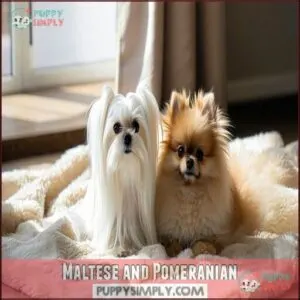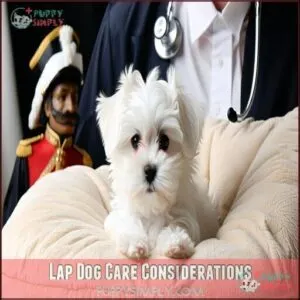This site is supported by our readers. We may earn a commission, at no cost to you, if you purchase through links.
 If you’re after the best lap dogs, look for breeds like the Cavalier King Charles Spaniel, Maltese, or Shih Tzu.
If you’re after the best lap dogs, look for breeds like the Cavalier King Charles Spaniel, Maltese, or Shih Tzu.
These pups are practically professional snugglers, always ready to warm your lap and your heart.
French Bulldogs bring a playful twist, while Chihuahuas are tiny but mighty cuddle enthusiasts.
Pomeranians? They’re like fluffy little clouds that adore being close.
Lap dogs are typically small, affectionate, and thrive on attention, making them perfect companions.
Just keep in mind their grooming needs, energy levels, and sometimes delicate health.
Ready to find your perfect cuddle buddy? These breeds might just steal your heart.
Table Of Contents
- Key Takeaways
- What Are Lap Dogs
- Choosing Lap Dogs
- Lap Dog Breed Characteristics
- Lap Dog Care Considerations
- Benefits of Lap Dogs
- Frequently Asked Questions (FAQs)
- What is the best lap dog to have?
- What is the #1 most cuddly dog?
- What is the easiest dog to keep?
- What lap dog barks the least?
- What dog is the best lap dog?
- What is the best dog for lazy owners?
- What is the best quiet lap dog?
- What dog breeds can be left alone for 8 hours?
- What is the most cuddly lap dog?
- Which dog can stay alone for 8 hours?
- Conclusion
Key Takeaways
- Choose lap dogs like the Cavalier King Charles Spaniel, Maltese, or Shih Tzu for their affectionate nature and manageable size.
- Match a dog’s temperament, grooming needs, and energy level to your lifestyle for a perfect companion.
- Regular grooming and vet check-ups are essential to keep your lap dog healthy and comfortable.
- Lap dogs offer emotional support, reduce stress, and make great companions for both busy owners and families.
What Are Lap Dogs
You’ll find lap dogs are small-to-medium sized breeds specifically bred for companionship, with the perfect size and temperament to curl up comfortably on your lap for hours of cuddle time.
These affectionate pups, from the tiny Chihuahua to the fluffy Bichon Frise, aren’t just sized for cozy snuggles – they’re genetically programmed to bond closely with their humans.
Making them the ultimate four-legged heating pads on chilly evenings.
Definition and Characteristics
Defining what makes a true lap dog goes beyond just size.
These pint-sized companions are specifically bred for human closeness and affection.
Bred for love and loyalty, these tiny dogs are the ultimate cuddle experts, thriving on human connection and affection.
While most lap dogs are small (typically under 22 pounds), their defining characteristics include cuddly temperaments, gentle dispositions, and an almost magnetic attraction to your lap.
They thrive on companionship and often form deep bonds with their owners—basically professional snugglers with four paws!
Popular Lap Dog Breeds
Loyal lapdogs have been stealing hearts for centuries.
You’ll find Bichon Frises, Shih Tzus, and Cavalier King Charles Spaniels topping the popularity charts for their cuddling prowess.
Chihuahuas and Pomeranians offer big personalities in tiny packages, while Maltese and French Bulldogs blend affection with distinct temperaments.
These small dogs combine rich breed history with manageable grooming needs, making them perfect companions for anyone craving a furry shadow.
Some breeds like poodles are known for their hypoallergenic qualities, making them suitable for allergy sufferers with their unique blend of characteristics, including being hypoallergenic and having manageable grooming needs.
Choosing Lap Dogs
You’ll want to think about a dog’s size, temperament, grooming needs, and energy level when picking your perfect lap companion.
Finding a pup that fits comfortably on your lap and matches your lifestyle will guarantee you both enjoy those cozy cuddle sessions for years to come, with a lifestyle that suits you both.
Ideal Size for Comfortable Lap Sitting
When choosing a lap dog, size matters more than you might think! You’ll want a pup that fits comfortably on your lap without causing discomfort to either of you.
- Dogs under 20 pounds typically make ideal lap companions
- Consider your own lap size—smaller humans may prefer dogs under 10 pounds
- Compact, well-proportioned breeds like Maltese adapt better to lap sitting
- Long-legged breeds (even small ones) might find cuddling awkward
- Rounded body types often settle more comfortably than angular frames, making them a great choice for a lap dog with a comfortable fit.
Temperament and Affection Level
When selecting your perfect lap companion, temperament and affection level matter just as much as size.
You’ll want a dog that genuinely enjoys cuddling rather than merely tolerating it.
| Temperament Trait | Impact on Lap Sitting | Training Impact | Child Compatibility |
|---|---|---|---|
| Affectionate | Seeks cuddles often | Willing to please | Generally good |
| Independent | Occasional snuggles | Might resist | Less patient |
| Anxious | Clingy lap behavior | Needs consistency | May be skittish |
| Confident | Cuddles on their terms | Responds well | Usually tolerant |
The key to a happy lap sitting experience is finding a dog with a compatible temperament that enjoys cuddling and has a good level of affection, making them a great companion for both adults and children.
Grooming Needs and Requirements
While a dog’s affection matters, their coat needs your attention too.
Lap dog grooming varies widely – some need daily brushing while others require professional grooming every 4-6 weeks.
Long-haired breeds like Maltese demand more coat maintenance than short-haired Chihuahuas.
Consider your time commitment before choosing; that Pomeranian’s gorgeous fluff comes with significant shedding control requirements and regular at-home care between salon visits.
Many owners find it helpful to invest in specialized grooming products.
Energy Level and Exercise Needs
Contrary to popular belief, lap dogs still need regular exercise despite their small stature.
Even tiny lap dogs need daily exercise to stay healthy—short walks and playtime keep their small bodies and big hearts thriving.
You’ll want to match your dog’s energy level with your lifestyle—most lap breeds need 20-30 minutes of daily activity.
Low energy dogs like Shih Tzus and Cavaliers thrive with gentle walks, while Pomeranians require more stimulation.
Indoor exercise works well for these pups, but adjust frequency based on age considerations, ensuring a suitable level of exercise.
Lap Dog Breed Characteristics
You’ll find that the perfect lap dog combines a compact size with a personality that craves human connection, making them natural cuddle companions.
From the fluffy Bichon Frise to the tiny Chihuahua, these breeds share traits like moderate activity levels and affectionate temperaments that make them happiest when they’re snuggled up with you.
Bichon Frise and Cavalier King Charles Spaniel
Now that you’ve found your perfect lap-sized companion, let’s look at two popular breeds that love nothing more than snuggling up with their humans.
The Bichon Frise and Cavalier King Charles Spaniel both make exceptional lap dogs, though they differ in key ways.
- Coat Differences: Bichons have hypoallergenic, fluffy white coats requiring regular grooming, while Cavaliers sport silky, medium-length fur in various colors
- Temperament Comparison: Bichons are playful and animated, while Cavaliers are calm and adaptable
- Health Concerns: Bichons are generally healthy, but Cavaliers need monitoring for heart and eye conditions
French Bulldog and Shih Tzu
These two popular lap dogs offer distinct experiences for cuddle enthusiasts.
French Bulldogs bring playful charm while Shih Tzus deliver royal elegance to your lap.
| Breed Feature | French Bulldog | Shih Tzu |
|---|---|---|
| Size | 11-14 inches, 16-28 lbs | 9-10 inches, 9-16 lbs |
| Grooming | Low maintenance, short coat | High maintenance, long flowing coat |
| Temperament | Vivacious, trainable Frenchie temperament | Calm, alert watchdog nature |
You’ll find both adapt wonderfully to small apartment living and rank among the best dogs for cuddling.
Maltese and Pomeranian
While French Bulldogs and Shih Tzus charm with their unique looks, the Maltese and Pomeranian win hearts with their elegant appearance and bold personalities. These tiny lap dogs pack big character into small packages!
When comparing these breeds, you’ll notice:
- The Maltese temperament is gentle and affectionate, while Pomeranians are more spirited and independent
- Pomeranian grooming requires weekly brushing for their fluffy double coat
- Both breeds make excellent companions, but have different health concerns
Chihuahua and Italian Greyhound
While Maltese and Pomeranians steal hearts with their fluffy coats, the tiny Chihuahua and elegant Italian Greyhound offer different lap dog charms.
These small dog breeds make affectionate companions, though Chihuahuas bring sass while Greyhounds offer quiet elegance.
Some Chihuahua’s also require attention to grooming and coat care to prevent matting, which is an important aspect of lap dog ownership and grooming needs, ensuring the health and well-being of these pets.
Lap Dog Care Considerations
You’ll need to give your lap dog special care, from serving smaller, more frequent meals to watching out for their temperature sensitivity and fragile bodies that can make them shiver like fuzzy cell phones on vibrate.
While these pint-sized pups might think they’re as tough as Great Danes, their tiny frames require regular vet check-ups to stay healthy and prevent the Napoleon complex from turning into actual health problems, which can be a significant issue for their fragile bodies.
Small Breed Dog Food Requirements
Now that you know which lap dog breeds might suit you, let’s talk about keeping their tiny tummies happy.
Your small dog’s food needs are quite different from larger breeds. They need calorie-dense meals with high-quality proteins and fats.
Due to their size and weight, small dog breeds require nutrient-rich food in smaller portions to support their faster metabolism, dental health, and overall well-being.
It’s important to research appropriate lap dog food for your pet. Consider supplement needs based on your vet’s advice to ensure the best for your small dog.
Frequent Feedings and Nutrition
Beyond specialized food, your lap dog’s eating schedule matters just as much. Their tiny tummies can’t handle large meals, so frequent feedings are key to maintaining stable blood sugar levels.
- Feed adult lap dogs 2-3 small meals daily to prevent hypoglycemia
- Monitor calorie requirements closely—just 40 extra calories daily can lead to obesity
- Consider dietary restrictions like grain-free options for sensitive pups
Always keep fresh water available to meet their hydration needs.
Fragile Bodies and Temperature Sensitivity
Most lap dogs have fragile bodies that require careful handling. Their small size affects temperature regulation, making them vulnerable to both heat and cold extremes.
They can’t regulate body heat like larger dogs, so you’ll need to monitor your lap dog during temperature extremes. Some owners opt to provide dog calcium supplements for breeds prone to low bone density.
| Issue | Affected Breeds | Prevention Tips |
|---|---|---|
| Low bone density | Chihuahua, Italian Greyhound | Provide calcium supplements |
| Joint problems | Bichon Frise, Cavalier | Use ramps for furniture |
| Hypoglycemia risks | Toy breeds under 5 lbs | Feed small, frequent meals |
| Overheating | Brachycephalic/flat-faced dogs | Avoid midday heat, provide shade |
| Cold sensitivity | Short-haired breeds | Use sweaters in winter |
You can take several steps to prevent common issues in lap dogs, including providing calcium supplements and using ramps for furniture to prevent joint problems. Additionally, being aware of hypoglycemia risks and taking steps to prevent overheating and cold sensitivity can help keep your lap dog safe and healthy.
Napoleon Syndrome and Health Issues
Despite their adorable size, your lap dog might develop "Napoleon Syndrome" – small dog aggression stemming from how you treat them rather than genetic predispositions.
When owners excuse bad behavior as "cute", it reinforces behavioral problems that can affect your Chihuahua or other small breed’s health.
Common ailments related to this syndrome often require preventative care.
Set consistent boundaries and avoid over-coddling to guarantee your tiny companion stays physically and mentally "healthy".
Regular Veterinary Check-Ups
Regular care is the cornerstone of your lap dog’s health journey.
Schedule veterinary check-ups twice yearly, as small breeds often develop issues that require early detection. Your tiny companion needs consistent parasite prevention, dental health screenings, and age-appropriate vaccination schedules.
As they become seniors, increase visits to catch problems sooner. Remember, routine care for these pint-sized pups is like insurance for their happiness—small investment, big returns.
For senior dogs, consider biannual wellness checks to monitor their health more closely, ensuring a happy and healthy life.
Benefits of Lap Dogs
You’ll find that lap dogs offer more than just cuddles—they provide genuine emotional support while fitting perfectly into your busy lifestyle.
Having a small, affectionate companion curled up with you after a long day isn’t just cozy, it’s actually good for your health too, lowering stress and blood pressure when you need it most.
Companionship and Social Benefits
While caring for your lap dog requires attention to their unique needs, the companionship they provide is truly special.
Your small furry friend offers incredible social benefits:
- They’re natural conversation starters when meeting new people
- They reduce loneliness by providing constant companionship
- They bring family members together through shared care responsibilities
- They create social opportunities through dog parks and pet-friendly gatherings
Affectionate breeds like lap dogs don’t just sit pretty—they connect you to a whole community! They provide constant companionship.
Emotional and Mental Health Benefits
Beyond the joy of companionship, your lap dog offers impressive emotional and mental health benefits.
These small companions excel at anxiety reduction and stress relief. Feeling blue? The warm weight of your furry friend can trigger mood enhancement almost instantly.
Many lap breeds make the best emotional support dogs, preventing loneliness while encouraging social interaction. Small dogs for anxiety aren’t just pets—they’re furry therapists who offer unconditional love whenever you need it most.
Best Lap Dogs for Allergy Sufferers
If allergies have you sneezing whenever a furry friend comes near, you’re not alone.
Hypoallergenic lap dogs like the Maltese, Bichon Frise, and Miniature Schnauzer produce less dander and shed minimally.
The Havanese‘s silky coat and Peruvian Inca Orchid’s hairless variety are perfect for allergy management.
Regular grooming frequency and air purifiers can help too.
These small non-shedding dogs let you enjoy cuddles without reaching for tissues!
Best Lap Dogs for Busy Owners and Families
While hypoallergenic lap dogs help sneeze-prone families, busy households need breeds that can handle some alone time too.
The Grand Basset Griffon Vendeen and Clumber Spaniel are perfect for apartment living—they’re content to snooze after their daily walks.
Shih Tzus make loving companions for families with kids, while Pomeranians bring entertainment value despite potential separation anxiety.
Chihuahuas, those pocket-sized affectionate small breeds, need minimal exercise and grooming, making them among the best companion dogs for your busy lifestyle.
Consider breeds such as the Shiba Inu’s independence for less demanding care, which is ideal for full-time workers and those seeking low-maintenance pets.
Frequently Asked Questions (FAQs)
What is the best lap dog to have?
Picking the best lap dog is like choosing your favorite cozy blanket—it depends on your vibe.
A Cavalier King Charles Spaniel is affectionate and adaptable, while a Chihuahua charms with independence.
Match their personality to yours!
What is the #1 most cuddly dog?
If you’re after ultimate cuddles, the Cavalier King Charles Spaniel takes the crown.
They’re affectionate, love being close, and practically melt into your lap.
It’s like having a furry, heartwarming blanket that adores you!
What is the easiest dog to keep?
Isn’t it great when a dog practically takes care of itself?
Chihuahuas are low-maintenance champs—tiny, independent, and needing minimal grooming.
Just keep them warm, offer love, and they’ll happily curl up in your lap.
What lap dog barks the least?
If you want a quiet lap dog, consider the Cavalier King Charles Spaniel.
They’re usually calm and not prone to excessive barking—perfect for snuggles without the noise.
Plus, their affectionate nature is a bonus!
What dog is the best lap dog?
The best lap dog depends on your vibe.
Love cuddles? Try a Cavalier King Charles Spaniel. Prefer independence? A Chihuahua might fit.
Each breed has quirks, so match their personality to yours for a perfect snuggle buddy.
What is the best dog for lazy owners?
If you’re on the lazier side, a French Bulldog is your soulmate.
They’re low-energy, love lounging, and need minimal grooming.
Just a short walk and they’re content to snuggle up all day!
What is the best quiet lap dog?
You might think quiet lap dogs don’t exist, but the Bolognese proves otherwise.
They’re calm, loyal, and love cuddling without constant barking.
Plus, their relaxed vibe makes them perfect for peaceful snuggle sessions.
What dog breeds can be left alone for 8 hours?
Breeds like the Bichon Frise, Cavalier King Charles Spaniel, and French Bulldog can handle being alone for 8 hours.
But make sure they’ve got toys, a cozy spot, and bathroom breaks before leaving!
What is the most cuddly lap dog?
Imagine a fluffy cloud curling into your lap—that’s the Bichon Frise.
With its affectionate, social nature and love for snuggles, it’s like having a living teddy bear who adores being close to you.
Which dog can stay alone for 8 hours?
A Bolognese or Cavalier King Charles Spaniel can handle being alone for up to 8 hours if trained early.
Just leave toys, comfy spots, and maybe some background noise to keep them content.
Conclusion
Imagine this: a rainy afternoon, your Cavalier King Charles Spaniel curled up on your lap, radiating warmth.
That’s the magic of the best lap dogs—they’re affectionate, comforting, and always ready to snuggle.
Whether it’s the playful French Bulldog or the delicate Maltese, there’s a breed for everyone.
Just remember their grooming, exercise, and health needs to keep them happy.
With the right care, these tiny companions will fill your days with love, laughter, and endless cuddles.

















